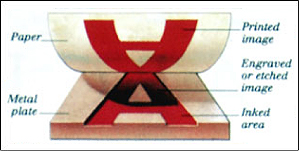This
is the reverse of Relief
Printing. Intaglio comes
from the Italian word Intagliare,
meaning, "to incise". In
Intaglio Printing, an image
is incised with a pointed
tool or "bitten" with acid
into a metal plate, usually
copper or zinc. The plate
is covered with ink, and
then wiped so that only
the incised grooves contain
ink. The plate and a dampened
sheet of paper are then
run through a press together
to create the print. Usually
the paper sheet is larger
than the plate so that the
physical impress of the
plate edges, or the plate
mark, shows on the paper.
The ink on the print tends
to be slightly raised above
the surface of the paper.
The various Intaglio printing
techniques are...
 Engraving
Engraving
Engraving is a process in
which a plate is marked
or incised with a tool called
a burin. A burin works on
a copper plate like a plough
on a field. As it is moved
across the plate, copper
shavings, called burr, are
forced to either side of
the lines being created
and these are usually cleaned
from the plate before inking.
An engraved line may be
deep or fine, has a sharp
and clean appearance and
tapers to an end. The process
is slow and painstaking
and generally produces formal-looking
results.
Drypoint
Drypoint prints are created
by drawing on to a metal
plate by scratching with
a needle or other sharp
tool. The technique allows
the greatest freedom of
line, from the most delicate
hairline to the heaviest
gash. In drypoint the
burr is not scraped away
before printing but stays
on the surface of the
plate to print a velvety
cloud of ink until it
is worn away by repeated
printings. Drypoint plates
(particularly the burr
on them) wear more quickly
than etched or engraved
plates and therefore allow
for fewer satisfactory
impressions and show far
greater differences from
first impression to last.
Mezzotint
Mezzotint is a technique
of engraving areas of
tone rather than lines.
In this method, the entire
surface of the plate is
roughened by a spiked
tool, called a rocker,
so that, if inked at that
point, the entire plate
would print in solid black.
The artist then works
"from black to white"
by scraping or burnishing
areas so that they will
hold less or no ink, yielding
modulated tones. Because
of its capabilities for
producing almost infinite
gradations of tone and
tonal areas, mezzotint
has been the most successful
technique for the black-and-white
adaptation of oil-painted
images to the print medium.
Etching
Etching has been a favoured
technique for artists
for centuries, largely
because the method of
inscribing the image is
so similar to drawing
with a pencil or pen.
An etching begins with
a metal plate (originally
iron but now usually copper)
that has been coated with
a waxy substance called
a "ground".
The artist creates the
composition by drawing
through the ground with
a stylus to expose the
metal. The plate is then
immersed in an acid bath,
which "bites"
or chemically dissolves
the metal in the exposed
lines. For printing, the
ground is removed; the
plate is inked and then
wiped clean. It is then
covered with a sheet of
dampened paper and run
through a press, which
not only transfers the
ink but also forces the
paper into the lines,
resulting in the raised
character of the lines
on the impression. Etched
lines usually have blunt
rather than tapering ends.
Aquatint
Aquatint is an etching
process concerned with
areas of tone rather than
line. For this technique,
the plate is covered with
a ground or resin that
is granular rather than
solid (as in etching)
and bitten, like etching,
with acid. The acid bites
between the granules.
The design, wholly in
tonal areas not line,
is produced by protecting
certain areas of the plate
from the acid with an
impervious varnish, by
multiple biting to produce
different degrees of darkness,
and by the use of several
different resins with
different grains.
Spitbite Aquatint
Spitbite Aquatint involves
painting strong acid directly
onto the aquatint ground
of a prepared plate. Depending
upon the time the acid
is left on the plate,
light to dark tones can
be achieved. To control
the acid application,
saliva, ethylene glycol
or Kodak Photoflo solution
can be used. Traditionally
a clean brush was coated
with saliva, dipped into
nitric acid and brushed
onto the ground, hence
the term "spitbite".
An earlier but related
technique, usually called
lavis, involved painting
the plate directly with
acid rather than ink,
and then washing it off
when the desired effect
had been achieved. Used
usually - and only by
certain artists - in conjunction
with etching, there are
few known prints of pure
lavis work.